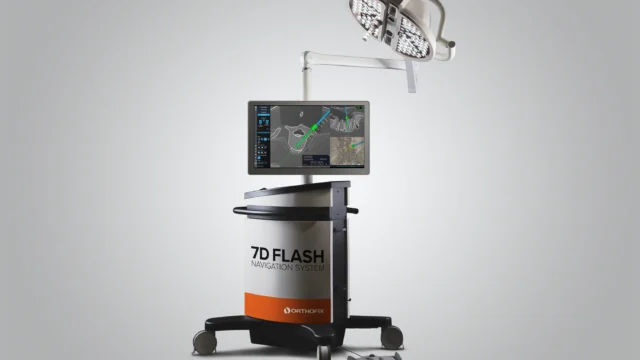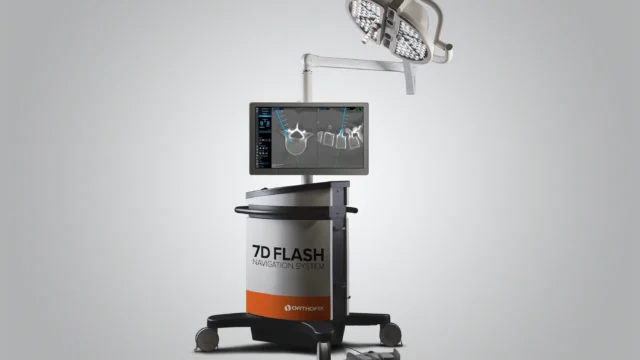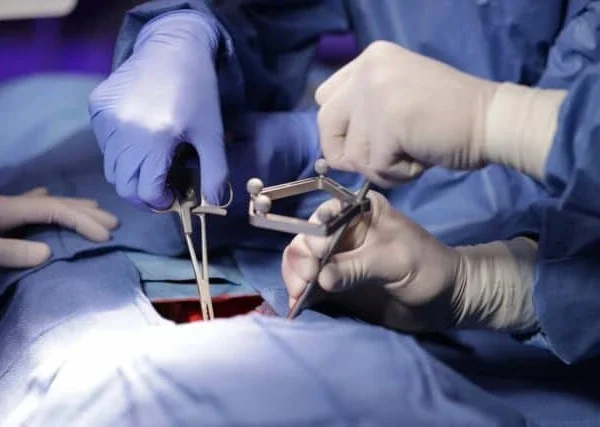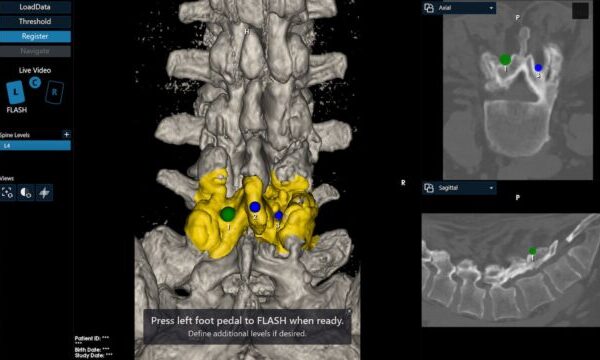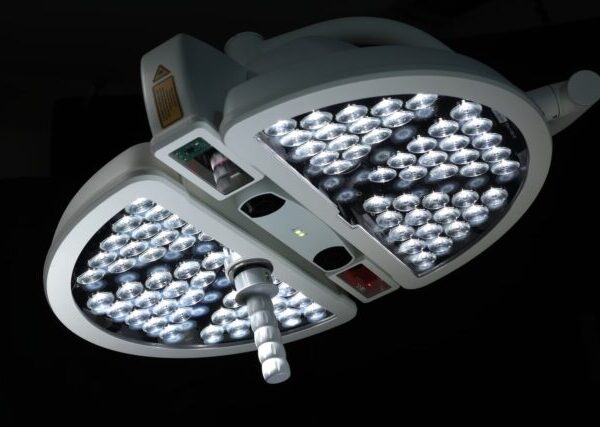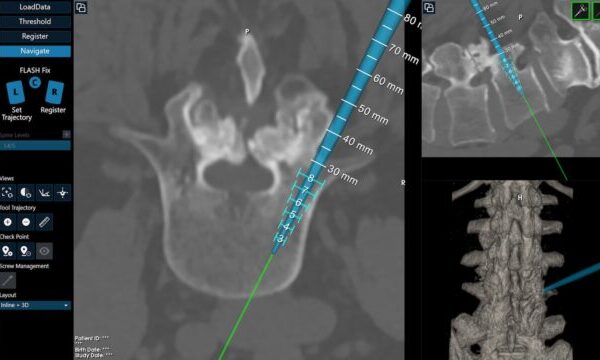Spine Navigation
Orthofix has developed the world’s first spine navigation system featuring machine-vision technology. The 7D FLASH™ Navigation System provides surgeons with a fast, efficient, radiation-free*, and cost-effective solution for spine navigation.
The Future Is Here, And It’s Bright
FLASH Registration, Simplified
7D Technology Does Even More
FLASH Fix
Fast, seamless reregistration in as low as 20 seconds. FLASH Fix eliminates radiation intensive and time-consuming re-registration methods if the reference array moves.
FLASH Trajectory
Provides real-time implant sizing and virtual screw trajectories to enhance surgical workflow efficiencies.
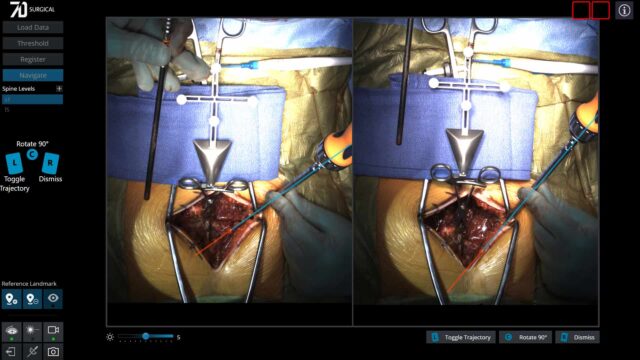
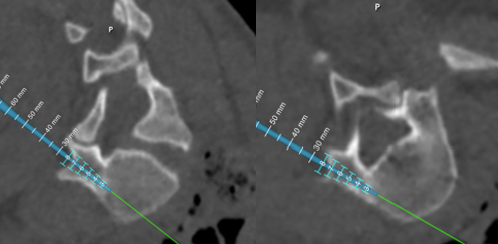
Re-Slicer
Provides accurate views of sagittal and axial planes at every level, allowing the surgeon to optimize visualization with severely rotated vertebral bodies.
Planning Software
The Planning Workspace empowers surgeons before entering the OR, enabling surgeons to review DICOM data, take key measurements (disc space, angular alignment, etc.), and pre-plan screw placement. The Screw Planning feature lets you place a virtual screw of a specified size, designed for seamless alignment during navigation to the entry point and trajectory of the preplanned screw. This can enhance efficiency, reduce intraoperative adjustments, and optimize construct alignment — especially for longer constructs where tulip head alignment simplifies rod bending.
Empowering Surgeons. Transforming Healthcare.
Orthofix is committed to advancing the standard-of-care for patients and surgeons. Eliminating unnecessary radiation exposure is just one of the many important steps to increase safety and awareness in image-guided navigation.
Did You Know?
Pediatric scoliosis patients can have a 5 times higher incidence of cancer due to radiation exposure.1
Radiation technologists are at a higher risk of leukemia diagnosis.2
Female orthopedic surgeons have a higher prevalence of ovarian cancer.3
Intraoperative navigation will generate approximately one iatrogenic malignancy for every 1,000 patients treated.4
Spine surgeons receive 10–12 times greater radiation levels than other, non-spinal procedures that involve the use of a fluoroscope.5
Physicians exceed their Lifetime Occupational Radiation Limit within the first decade of their career.6

See the 7D FLASH Navigation System in Action
Want to see exactly how the 7D FLASH Navigation System works? Click the button below to schedule a personal virtual demo or visit a live case at a peer-to-peer visit. It only takes a few seconds to understand why this is the best image-guided navigation system available for surgeons, hospitals, and patients.
References
- Simony A, Hansen EJ, Christensen SB, Carreon LY, Andersen MO. Incidence of cancer in adolescent idiopathic scoliosis patients treated 25 years previously. Eur Spine J. 2016 Oct;25(10):3366-3370. doi: 10.1007/s00586-016-4747-2. Epub 2016 Sep 3. PMID: 27592106.
- Richardson, D. B., Cardis, E., Daniels, R. D., Gillies, M., Haylock, R., Leuraud, K., … & Thierry-Chef, I. (2015). Risk of cancer from occupational exposure to ionizing radiation: retrospective cohort study of workers in France, the United Kingdom, and the United States (INWORKS). BMJ, 351, h5359. https://doi.org/10.1136/bmj.h5359
- Chou, L. B., Johnson, B., Shapiro, L. M., Pun, S., Cannada, L. K., Chen, A. F., Valone, L. C., Van Nortwick, S. S., Ladd, A. L., & Finlay, A. K. (2022). Increased prevalence of breast and all-cause cancer in female orthopaedic surgeons. JAAOS Global Research & Reviews, 6, e22.00031. https://doi.org/10.5435/JAAOSGlobal-D-22-00031
- (1.Striano BM, Crawford AM, Verhofste BP, Hresko AM, Hedequist DJ, Schoenfeld AJ, Simpson AK. Intraoperative navigation increases the projected lifetime cancer risk in patients undergoing surgery for adolescent idiopathic scoliosis. Spine J. 2024 Jan 21:S1529-9430(24)00018-4. doi: 10.1016/j.spinee.2024.01.007. Epub ahead of print. PMID: 38262498.)
- Rampersaud, Y. R., Foley, K. T., Shen, A. C., Williams, S., & Solomito, M. (2000). Radiation exposure to the spine surgeon during fluoroscopically assisted pedicle screw insertion. Spine, 25(12), 1538-1544. https://doi.org/10.1097/00007632-200006150-00016
- “Radiation exposure during pedicle screw placement in adolescent idiopathic scoliosis: is fluoroscopy safe?” Ul Haque M, Shufflebarger HL, O’Brien M, Macagno A. Spine: 2006 Oct 1;31(21):2516-20
